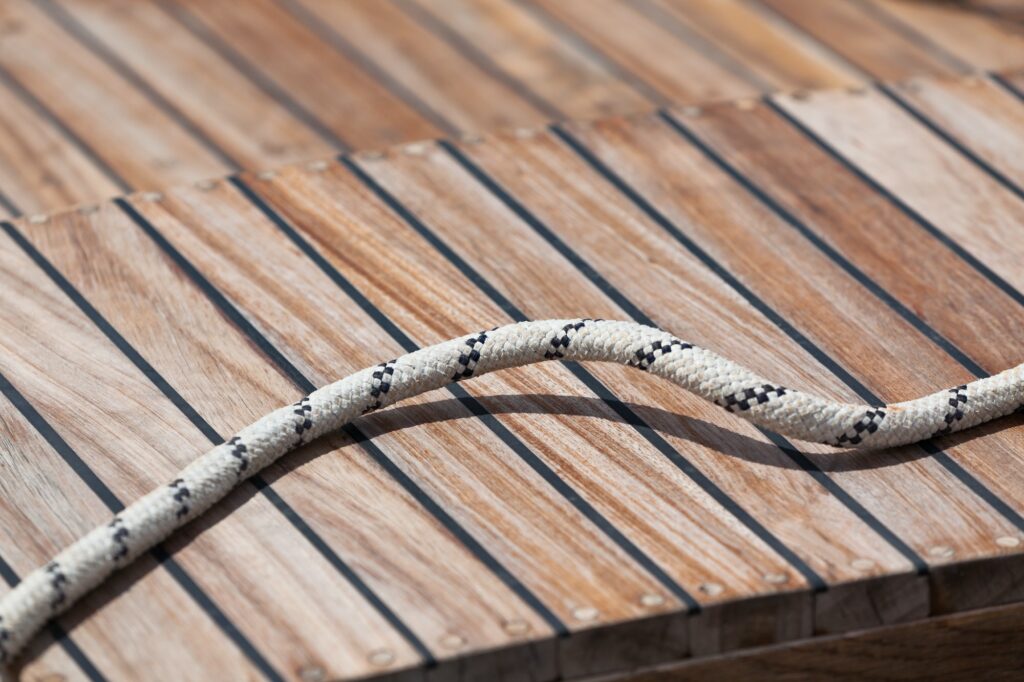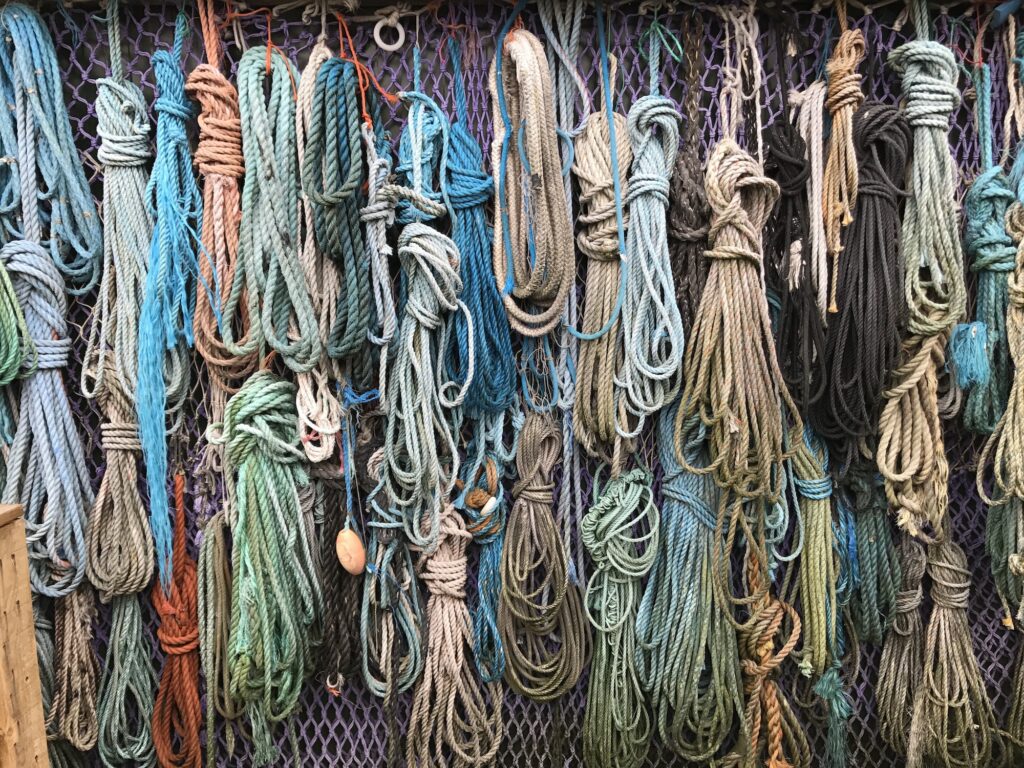Navigating the world of sailing boat ropes and lines can be confusing, especially if you’re new to boating. With a wide variety of materials each carrying different properties, it’s essential to understand what you’re working with.
This article will guide you through the types of ropes, their applications on a sailing yacht, and key factors to consider when choosing them for your vessel. Ready to untangle the knots? Let’s dive in!
Table of Contents
Table of Contents
Key Takeaways
- Sailboat running rigging is essential for controlling the sails and adjusting equipment on a sailing vessel, with halyards raising or lowering the sails and sheets fine-tuning their shape.
- High-performance running rigging, such as single braid lines with minimal stretch, offers strength and durability for hoisting and shaping sails.
- Value-performance running rigging provides affordable options that balance elasticity and performance for different types of sailing needs.
- Dock lines are crucial in securing boats at docks, with braided lines being popular due to their strength and durability.
Types of Sailing Lines and Ropes
Several types of sailing lines and ropes are commonly used on sailboats, including sailboat running rigging, high-performance running rig value-performance running rigging, and dock lines.
Sailboat Running Rigging
Sailboat running rigging plays a pivotal role in controlling the sails and adjusting equipment according to your needs on the water. It’s designed to be adjustable, allowing sailors to swiftly alter sail shapes and angles with lines like halyards and sheets.
Halyards serve the specific purpose of raising or lowering sails, giving you control over your boat’s speed and direction. Meanwhile, sheets offer fine-tune adjustments that change the shape of the sail, optimizing performance.
The importance of high-performance running rigging in sailing adventures cannot be overstated. These ropes and lines are responsible for hoisting, lowering, shaping, and adjusting sails on a boat and come in two main types: single-braid line and double-braid line.
Single braid lines are comfortable to handle due to their soft feel whereas double braid lines offer unrivaled strength and durability.
High-tech materials are often used in high-performance running rigging. Specifically, performance-oriented single-braid lines can withstand substantial loads with minimal stretch, making it easier to control your sails.
Selection becomes key here; sailors must opt for the right fit depending on their needs which might range from a basic polyester double-braid setup to these technologically advanced options.
Value Performance Running Rigging
Value-performance running rigging serves as an affordable and reliable choice for sailors. These ropes for boats possess strength and durability without breaking the bank. Vela Sailing Supply, among others, offers a wide range of these economical but robust marine rope options catering to different types of rope needs on a sailing boat.
Known for their elasticity that falls just right between running and rigging lines, products from Samson thrived in popularity among users aiming for precise balance performance. The type of boat line or sailor’s rope you choose greatly depends on your equipment specifications and intended use, enabling you to make the most out of your sailing adventure with value-performance running rigging options available in the market today.
Dock Lines
Dock lines are essential ropes used to secure boats in place at the dock. They play a crucial role in keeping your boat from drifting away or getting damaged while moored. When choosing dock lines, it is important to consider their strength, elasticity, and resistance to abrasion and UV damage.
Typically made from nylon material, dock lines come in three main types: three-strand, braided, and double braid. Braided lines are popular for their strength and durability, as they consist of multiple strands braided together.
So make sure you choose the right type of dock line that will keep your boat safe and secure at the dock.
Sailing Line Terminology
Sailing line terminology refers to the specific names and terms used to describe different types of ropes and lines in sailing. These terms are important for sailors to understand, as they help communicate instructions quickly and accurately during a sail.
For example, halyards are the lines that raise and lower the sails, while sheets are used to control the angle of the sails. Other examples include brails, vangs, tricing lines, warps, whips, and jackstays.
By familiarizing themselves with these sailing line terminologies, beginners can navigate their way through different maneuvers with ease. Understanding sailing line terminology is an essential part of becoming a proficient sailor.
Key Factors to Consider When Choosing Sailing Lines and Ropes

When choosing sailing lines and ropes, it is important to consider factors such as fiber type, strength, size, and color.
Fiber type
The type of fiber used in a rope plays a crucial role in its performance. Different fibers have different characteristics, which can affect factors such as stretch, strength, and durability.
For example, polyester braids are recommended for cruising because they are durable and resistant to UV rays. On the other hand, nylon is popular for docking and anchor lines due to its strength and energy absorption properties.
Samson ropes offer two categories based on fiber type: Class I and Class II. Additionally, polypropylene ropes are known for their buoyancy and resistance to various environmental conditions.
Strength
Strength is a crucial factor to consider when choosing the right sailing lines and ropes for your boat. You need lines that are strong enough to withstand the forces of wind and waves without breaking.
Very low stretch and high break strength are important priorities in ensuring the safety and reliability of your rigging. While breaking strength is significant, it may not always be the most critical factor when selecting lines for running rigging.
High-tech materials can provide advantages in terms of durability and performance, offering greater strength while maintaining a lightweight design. Therefore, it’s essential to carefully assess the strength associated with key factors when choosing sailing lines and ropes for your sailboat.
Size
Choosing the right size of the line is essential when selecting ropes and lines for your boat. The size of the line depends on various factors, including the length of your boat.
Mooring ropes for ships and jib sheets for sailboats also have specific diameter requirements. It’s important to consider the length, diameter, and thickness of the yarn when selecting lines for specific applications.
By choosing the correct size, you can ensure the efficient and effective operation of your vessel.
Color
Boat lines come in a variety of colors, and the choice of color is not just for aesthetics. Different lines on a sailboat must have distinct colors to easily identify their purpose and function.
This helps sailors quickly find and select the right line for each task or maneuver. For example, jib halyards are often red or black, mainsails are blue, spin halyards are green, mainsheets are black, and travelers can be blue/white.
These standard color codes allow sailors to organize their lines efficiently and ensure smooth sailing on the water. Additionally, the color coding system can provide valuable information about a line’s characteristics like strength and stretch based on the specific color assigned to each type of line.
Popular Brands of Sailing Lines and Ropes
Here are some popular brands of sailing lines and ropes to consider for your boat: AmSteel-Blue Dyneema, Excel Racing Dinghy Control Line, D2 Racing 78, Blue Ocean – Double Braid Polyester, and D2 Club.
Read on to discover which one suits your needs best.
AmSteel-Blue Dyneema
AmSteel-Blue Dyneema is a type of rope that is highly recommended for sailors. Made from Dyneema fiber, this rope offers exceptional strength and durability. It is known to have better bend fatigue characteristics compared to other grades of HMPE, making it ideal for mooring lines.
Additionally, AmSteel-Blue ropes are more abrasion resistant than high-carbon steel. This torque-free 12-strand braid ensures performance and reliability on the water, making it a top choice for sailors seeking quality and dependability in their sailing lines and ropes.
Excel Racing Dinghy Control Line
The Excel Racing Dinghy Control Line is a trusted choice for many sailors. It combines a 100% Polyester cover with a Dyneema® core, ensuring both durability and flexibility. This line is designed to hold well in cleats, providing secure and reliable performance on the water.
Sailors can rely on the strength of the Dyneema SK78 core for their halyards, sheets, and control lines. With its association with respected brands like Robline Dinghy Control and Marlow Excel Racing, the Excel Racing Dinghy Control Line is a top pick for those looking for high-quality ropes.
D2 Racing 78
D2 Racing 78 is a high-strength and lightweight sailing rope manufactured by Marlow Ropes Ltd. This popular brand in the sailing industry has designed this rope with a pre-stretched, bio-based D12 78 core to enhance its performance and durability.
One of the key features of D2 Racing 78 is its color-coded cover, making it easy for sailors to identify and use. It is commonly used for sailing applications such as halyards, sheets, control lines, out/downhauls, and reefing lines.
Sailors can rely on D2 Racing 78 to provide strength and reliability during their adventures on the water.
Blue Ocean – Double Braid Polyester
Blue Ocean – Double Braid Polyester is a unique marine rope that offers both strength and sustainability. Made from a polyester braid-on-braid construction, this line is associated with the renowned brand Marlow Ropes.
What sets Blue Ocean apart is its cover, which is crafted using a blend of 50% recycled polyester and 50% regular polyester. Specifically designed for yacht and dinghy halyards, sheets, and control lines, it combines high performance with eco-consciousness.
Blue Ocean is the world’s first sailing rope made entirely from recycled waste plastic bottles. Embrace durability while reducing your environmental impact with this innovative choice of ropes.
D2 Club
D2 Club is a well-known and trusted brand in the sailing and boating industry. They offer a wide range of high-quality lines and ropes, making them a go-to choice for sailors. With its extensive selection of sailboat lines and rigging options, D2 Club provides everything you need to ensure your boat is properly equipped for any adventure on the water.
Whether you’re looking for durable rope materials or top-notch running rigging, D2 Club has got you covered.
Sta-Set Sailing Line
Sta-Set is the go-to brand for sailing lines, trusted by sailors across America. It’s no wonder that more sailboats use Sta-Set than any other line. This double-braid rope is known for its strength, flexibility, and durability.
With low stretch and high strength, it’s perfect for various applications like halyards and reef lines. Sail with confidence knowing you have the #1 double braid in America on board – Sta-Set Sailing Line.
Vintage Sta-Set
Vintage Sta-Set is a premium grade double braided polyester rope that is highly regarded in the sailing community. Its low stretch and exceptional durability make it perfect for various applications on sailing boats, such as control lines, positioning, lifting, or lowering.
Crafted from high-tenacity polyester, Vintage Sta-Set is designed to withstand UV rays and chafing, ensuring its longevity even in harsh marine conditions. This popular line has been trusted by sailors for years and continues to be a reliable choice due to its strength and versatility.
It has been used on more sailboats than any other line on the market. Vintage Sta-Set can also be called polyester static rope alongside similar ropes frequently utilized in sailboat rigging.
Salsa Line
Salsa Line, produced by NER (New England Ropes), is a type of sailing line that serves as a reliable utility rope. While not commonly used among racing sailors, it is highly regarded for its knobby or fuzzy single-braid design, which provides excellent grip and handling.
Sailors often turn to Salsa Line for docking, anchoring, and rigging purposes in both sailboats and power boats. Its durability and versatility make it a popular choice for various applications on the water.
Proper Care and Maintenance of Sailing Lines and Ropes

Proper care and maintenance of sailing lines and ropes are crucial for ensuring their longevity and optimal performance. From washing and drying to regular inspections, learn how to take care of your boat’s lifelines in our latest blog post.
Don’t miss out on essential tips for keeping your ropes in top shape!
Washing and drying
To keep your sailing lines and ropes in top condition, proper care and maintenance is essential. When it comes to washing them, you have a few options. Soap shavings, gentle detergents, or special shampoos can be used to clean sailing and marine ropes.
Before washing, it’s recommended to pre-clean them with water jets. You should use a mild detergent with lower concentrations than what you would typically use for cleaning clothes or linens.
Most types of rope can tolerate higher water temperatures during washing. Once they’re clean, make sure to dry the ropes thoroughly. Hanging them up to dry is the best way to ensure they are ready for your next sailing adventure.
Regular inspection
Regular inspection is essential for maintaining the longevity and functionality of sailing lines and ropes. By conducting regular inspections, sailors can identify any signs of damage or wear before they escalate into bigger problems.
It is important to thoroughly check each rope from end to end, paying close attention to areas where friction is common, such as pulleys and cleats. Neglecting regular inspections can lead to the deterioration of boat lines and ropes, which could compromise their strength and ultimately jeopardize safety at sea.
Sailors should prioritize this maintenance task to ensure their equipment remains reliable during every voyage.
Proper storage
Proper storage is crucial for maintaining the longevity and performance of sailing lines and ropes. To keep your ropes in top condition, it’s important to sort and organize them to avoid tangling.
Coiling the lines properly not only prevents knots but also makes them easier to use when you’re out on the water. When it comes to storing your ropes, find a clean, dark place with room temperature and humidity levels that are neither too high nor too low.
This will help protect your ropes from damage caused by exposure to sunlight or extreme temperatures. By following these storage guidelines, your sailing lines can stay in great shape for up to five years.
Common Applications and Uses of Sailing Lines and Ropes
Sailing lines and ropes have a wide range of applications, including halyards for hoisting sails, sheets for controlling sail trim, control lines for adjusting various aspects of the rigging, dock lines for securing the boat to a dock or mooring ball, mooring lines for anchoring the boat in place, and anchor lines for setting and retrieving anchors.
Halyards
Halyards are essential lines used to hoist various items, such as sails, on a sailboat. They provide the means to raise and lower sails efficiently. The strength and stretch of a halyard line depend on its core material, while the cover offers protection and grip.
These lines come in varying lengths and thicknesses based on the size of the sailboat and the type of sail being hoisted. Common materials for halyard ropes include polyester, nylon, and Dyneema, ensuring durability and reliability during sailing adventures.
Sheets
A sailboat sheet is a crucial line that sailors use to control the movable corners of a sail, called clews. These sheets play a vital role in helping sailors adjust the angle of the sails to the wind, which directly affects the overall performance and speed of their boat.
Typically made from strong and durable materials like rope, cable, or chain, these sheets allow sailors to finely tune their sails’ trim and control. Polyester ropes are commonly used for halyards, mooring lines, and sheets on sailing boats due to their strength and reliability.
With well-chosen sheets in place, sailors can have better control over their boat’s speed and maintain an optimal course on the water.
Control Lines
Control lines are an essential component of a sailing boat’s running rigging. They include vangs, outhauls, cunninghams, reef lines, traveler lines, lead controls, and downhauls. These control lines play a significant role in adjusting and maintaining the trim of a sail to optimize the performance of the sailboat.
Double-braided ropes are commonly used for control lines as they provide strength and durability. Polyester ropes are also frequently utilized for various functions on a yacht due to their reliability.
By using control lines effectively, sailors can have better control over their sails and achieve optimal performance on the water.
Dock lines
Dock lines are an essential part of every sailor’s gear. These lines, typically made from nylon, are used to secure a boat to a dock or other fixed object. When choosing dock lines, it is important to consider the strength and size of the line to ensure it can withstand the forces and strains placed upon it.
To properly secure a boat, dock lines should be attached securely to a cleat or other fixed object on both the boat and the dock. Additionally, spring lines or other additional lines can be used in conjunction with dock lines for added stability and holding power.
Properly chosen and secured dock lines provide peace of mind while keeping your vessel safely moored.
Mooring lines
Mooring lines are thick and durable ropes used to secure a marine vessel to a dock, pile, or wharf. These lines play a crucial role in keeping the boat in place and preventing drifting or collisions.
Their diameter can vary depending on the size and weight of the boat. Generally, polyester ropes are commonly used for mooring lines due to their strength, durability, and resistance to UV degradation.
With these sturdy lines in place, sailors can have peace of mind knowing that their boats are securely anchored when not in use.
Anchor lines
Anchor lines, also known as anchor rods, are an essential part of any sailing boat. They allow you to attach the anchor securely to your vessel. Typically, an anchor ride consists of a combination of chain and rope.
The rope portion is what connects the anchor to your boat, providing stability and security while you’re at rest or when facing strong currents. These lines play a crucial role in keeping your boat safely anchored in place so that you can enjoy peace of mind during your sailing adventures.
Sailing ropes and lines have diverse applications, including docking, towing, rigging, and anchoring. So it’s important to choose the right type of line for each purpose – considering factors such as strength, size, and material type -to ensure they perform optimally and withstand the demands placed on them by wind conditions and waves.
Conclusion
Choosing the right ropes and lines for your sailing boat is crucial for a smooth and successful journey on the water. By considering factors such as fiber type, strength, size, and color, you can ensure that you have the right rope for each specific application on your sailboat.
Proper care and maintenance of your sailing lines will also prolong their lifespan and performance. So, take the time to research and invest in high-quality ropes to enhance your sailing experience.
Sailing Boat Ropes And Lines – FAQ
1. What are sailing boat ropes and lines?
Sailing boat ropes and lines are essential components of any sailboat rigging system. They are used for various purposes, such as hoisting and controlling sails, adjusting rig tension, and securing the boat to a dock or mooring. Ropes and lines are made from different materials like polyester, Dyneema, or polypropylene, and they come in various types and sizes to serve specific functions on a sailboat.
2. What is the difference between a rope and a line?
The terms “rope” and “line” are often used interchangeably in sailing, but there is a subtle difference between the two. Generally, a rope refers to raw material, whereas a line is a rope that has been cut to a specific length and has a particular purpose on a boat. For example, a long piece of rope used for various tasks on a sailboat can be called a rope, while a rope that is specifically used for hoisting the main sail is referred to as a halyard or a halyard line.
3. What are the different types of ropes and lines used on a sailing boat?
The different types of ropes and lines used on a sailing boat include halyards, sheets, dock lines, and furling lines.
4. How do I choose the right rope or line for my sailing boat?
When choosing the right rope or line for your sailing boat, consider factors such as the intended use (e.g., hoisting sails), load capacity, durability, and thickness.
5. How often should I inspect and replace the ropes and lines on my sailing boat?
It is important to regularly inspect your ropes and lines for signs of wear or damage. Depending on usage and exposure to elements, they may need replacement every few years.
6. Can I use any type of rope or line as a replacement for those specifically made for sailboats?
While it is possible to use other types of rope in an emergency situation, it is recommended to use ropes specifically designed for sailboats as they have features like low stretch and UV resistance that make them more suitable for sailing applications.
7. What are some common types of sailing boat ropes and lines?
There are several types of sailing boat ropes and lines commonly used on sailboats. Some of these include halyards, control lines, sheets, and dock lines. Halyards are used to hoist and lower the sails, control lines are used to adjust the position of sails or control the rig, sheets are used to control the angle of the sails, and dock lines are used to secure the boat when mooring or docking.
8. What are the advantages of using polyester ropes for sailing boats?
Polyester ropes are popular in the sailing community due to their excellent strength, durability, and UV resistance. They have low stretch characteristics, which makes them ideal for halyards and other applications where minimal elongation is desired. Polyester ropes also have good abrasion resistance, making them suitable for various sailing conditions.
9. What is Dyneema and why is it used in sailing ropes?
Dyneema is a high-performance synthetic fiber with a remarkable strength-to-weight ratio and excellent abrasion resistance. It is commonly used in sailing ropes due to its low stretch properties, making it ideal for applications where minimal elongation is desired, such as halyards and control lines. Dyneema ropes are also lightweight, which reduces the overall weight of the rigging system and improves performance.

